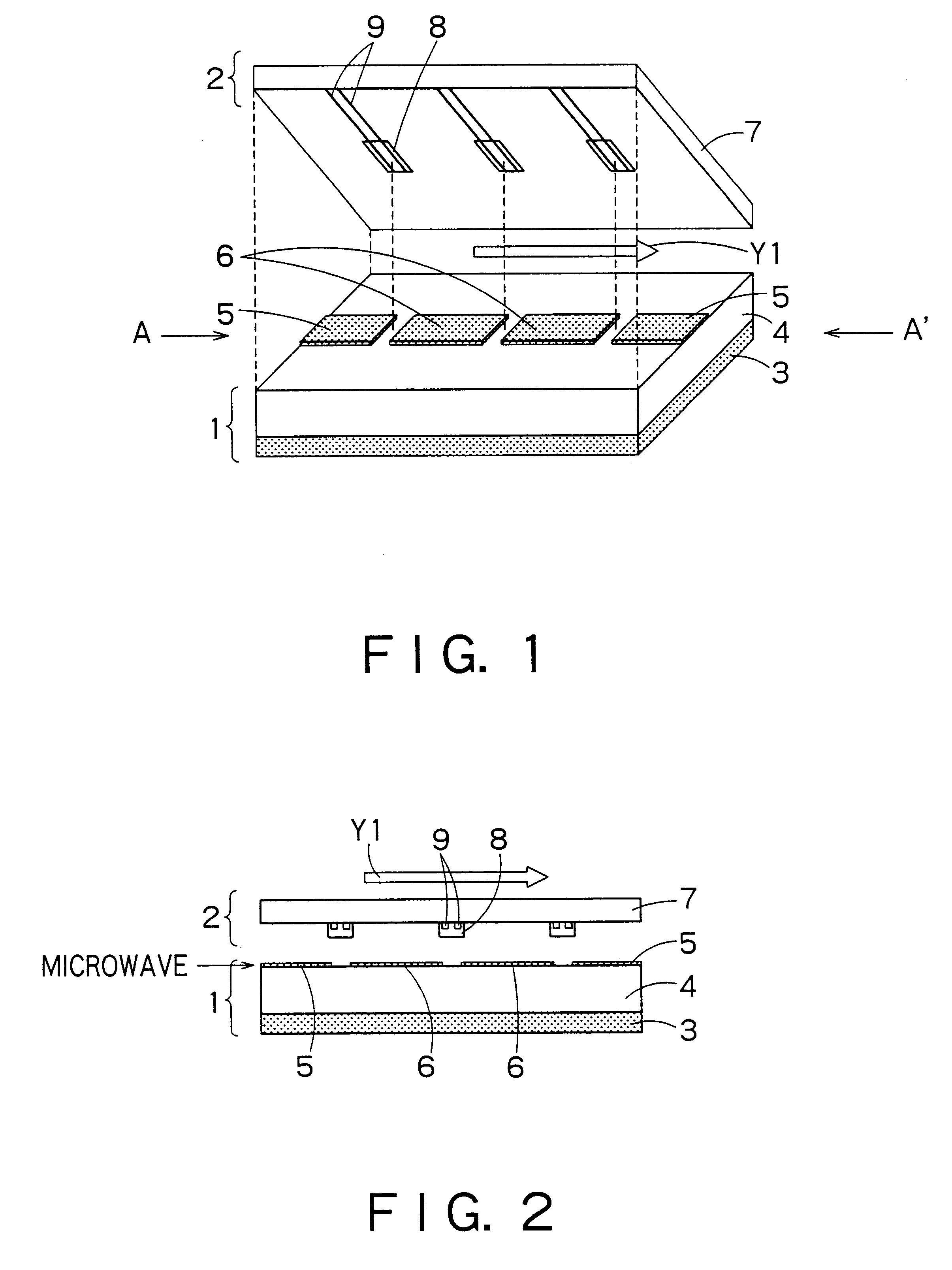Planar filter and filter system using a magnetic tuning member to provide permittivity adjustment
a filter system and magnetic tuning technology, applied in the field of planar filters, can solve the problems of large change in resonance properties, inability to obtain desired filter properties, and high degree of accuracy in adjusting resonance properties
- Summary
- Abstract
- Description
- Claims
- Application Information
AI Technical Summary
Benefits of technology
Problems solved by technology
Method used
Image
Examples
first embodiment
first concrete example described hereinafter is a concrete example of the filter of FIG. 1 described in the first embodiment, and a band pass filter of a micro-strip line structure of a 4.8 GHz band will be described.
In the present example, 0.5 mm thick LaAlO, was used as the substrate 4 of the filter member 1. A yttrium-based superconductor thin film was formed in 500 nm on both surfaces of the substrate 4 by a sputtering method, the superconductor thin film on one surface was used as the ground surface 3, the superconductor thin film of the other surface was processed using an ion milling method, the input / output portion 5 and a plurality of resonance elements 6 with a desired resonance frequency were formed, and the filter member 1 of the micro-strip line structure was prepared.
Each resonance element 6 obtained a width of 170 .mu.m, length of 8 mm, and resonance frequency of 4.8 GHz. Moreover, a 100 .mu.m gap was disposed between the resonance elements 6, and a 70 .mu.m gap was d...
second concrete example
A second concrete example described hereinafter is, similarly as the first concrete example, a concrete example of the first embodiment, and an example with a pass frequency band of about 2 GHz is shown.
FIGS. 11A-11C are views showing a structure of the second concrete example of the planar filter. FIG. 11A is a plan view of the filter member 1, FIG. 11B is a plan view of the tuning member 2, and FIG. 11C is a sectional view of the planar filter.
The planar filter of FIGS. 11A and 11C are similar in structure and manufacture method to the planar filter of FIG. 1, except that the shape of the resonance element 6 on the filter member 1 is different. Therefore, a detailed description of the elements shown in FIGS. 11A-11C has been provided with respect to FIG. 1 and is not repeated in relation to FIGS. 11A-11C.
As shown in the equation (1), when the resonance frequency is lowered, the length L of the resonance element 6 is lengthened. Therefore, in the filter member 1 of FIG. 11A, the re...
third concrete example
A third concrete example described hereinafter is a concrete example of the filter of FIGS. 4A and 4B described in the second embodiment.
In the third concrete example, the planar filter shown in FIGS. 4A and 4B was prepared in the following method. On both surfaces of the single-crystal substrate 4 of LaAlO.sub.3 with a longitudinal size of 40 mm, lateral size of 20 mm and thickness of 0.5 mm, a 500 nm thick YBCO superconductor film was formed by the sputtering method, laser vapor deposition method, CVD method, or the like. Next, one surface was processed by a lithography method to form the input / output portion 5 and resonance element 6, and then the back surface of the substrate was used as the ground surface 3 and a two-stage band pass filter of a micro-strip structure was prepared.
The width of the resonance element 6 was set to 170 .mu.m, the length thereof was 8 mm, the gap between the resonance elements 6 was 100 .mu.m, and the gap between the resonance element 6 and the input / ...
PUM
| Property | Measurement | Unit |
|---|---|---|
| thick | aaaaa | aaaaa |
| length | aaaaa | aaaaa |
| length | aaaaa | aaaaa |
Abstract
Description
Claims
Application Information
 Login to View More
Login to View More - R&D
- Intellectual Property
- Life Sciences
- Materials
- Tech Scout
- Unparalleled Data Quality
- Higher Quality Content
- 60% Fewer Hallucinations
Browse by: Latest US Patents, China's latest patents, Technical Efficacy Thesaurus, Application Domain, Technology Topic, Popular Technical Reports.
© 2025 PatSnap. All rights reserved.Legal|Privacy policy|Modern Slavery Act Transparency Statement|Sitemap|About US| Contact US: help@patsnap.com



